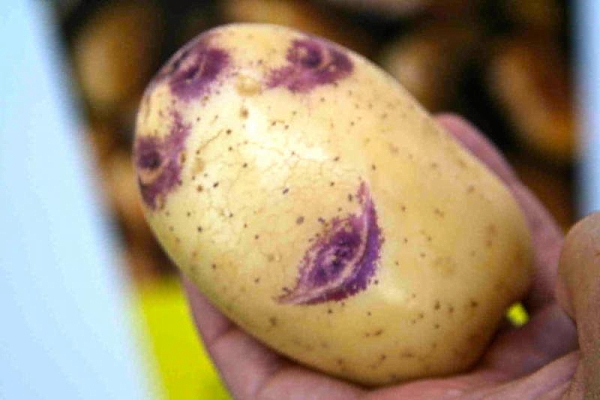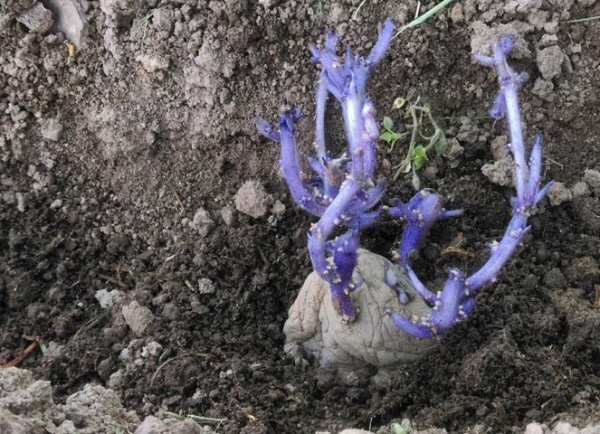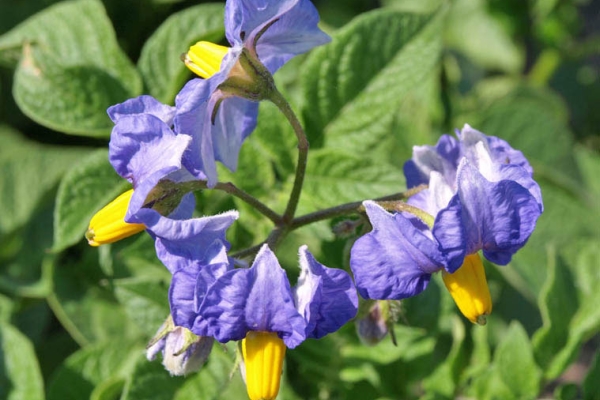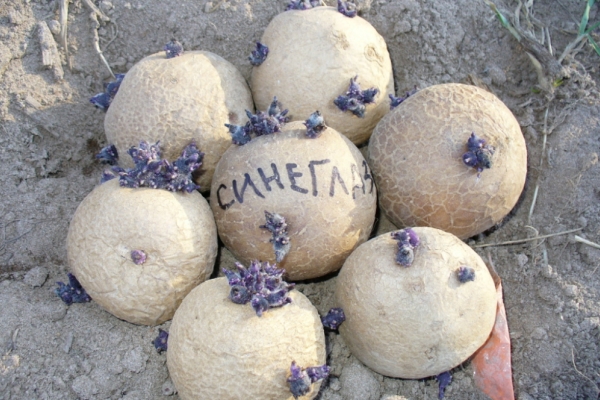Potato variety Sineglazka refers to mid-season varieties. Tubers begin to form early.
It is grown mainly in home gardens. On an industrial scale not received. In terms of simplicity in care and taste, it competes with the hybrid varieties of the newest selection.
Sineglazka known for a long time, this variety is preferred by gardeners with the experience, periodically updating sowing material. I remember that our grandmothers still hunted for this variety and sought to dissolve the culture in their own garden.
Table of contents
Description of potato varieties Sineglazka
Middle-ripe variety, tubers are large, oval-oblong. The peel has a light bluish tint. The eyes are dark, more even purple, are on the surface, not numerous.
Bluegrass bushes are very strongA lot of green mass is formed, the stems are strong. The root system is developed perfectly. The flowers are light blue in color and the leaves are dark green.
Specifications
Sineglazki has a very long growing season.that makes it possible to harvest for a long time. Tubers grow the same, even, regular shape.
Requires periodic seed upgrades (once in 4-5 years). Otherwise, it begins to undergo diseases, degenerate, the crop becomes small and loses its presentation.
The most common diseases of the potato shows resistance. This is primarily scab, nematode, potato cancer, various viruses.
When digging almost does not damage, grows in a heap, does not “creep away” beyond the limits of the hole. Because of the problems with the preservation of the crop is not suitable for industrial cultivation.

Pros and cons of potatoes
Appreciated for its incredible taste and yield. The pulp in the cut is white, has in its composition 15% starch.
Contains many vitamins of group B, proteins and minerals necessary for an organism.
Seed renewal is also problematic.: this is done for a long time, it requires hassle and physical costs. Not everyone is ready to do this procedure.
Ideal variety for appetizing mashed potatoes - Sineglazka:
Reviews
Despite these shortcomings, the grade is winning positive feedback from gardenerswho manage to save the harvest right up to spring.
By the recognition of gardeners, Nowadays it’s very problematic to get seed.
This happens due to the fact that now on the market there are mainly the newest hybrids, which demonstrate the best parameters, regardless of unsightly taste qualities.
You can get Sineglazka except from your fellow gardeners in exchange.

Growing up
When determining the timing of planting, it is necessary to take into account the peculiarities of the climatic zone. Usually, seed material is sent to the ground in the last decade of April.
If you want to get the harvest as soon as possible, then plant under the film cover.
To avoid further problems before planting, the tubers are germinatedand then carry out preventive treatment for diseases and pests.
They also use mineral and phosphate fertilizers, but this is also done in the fall.
When landing the recommended width of the beds is a little over half a meter. Thanks to this, it is possible to easily penetrate the sun's rays and facilitate further care of the culture.
The wells are located 35-40 centimeters apartand the depth reaches 10-12 centimeters. As a rule, 50-60 grams of ash is poured into each of them.

Care rules
Sineglazka does not like water stagnationThis fact is taken into account when organizing irrigation. As soon as the sprouts that appear on the surface reach a size of 5-7 centimeters, the culture should be mined and weeds should be removed.
At the same time, the first dressing consisting of nitrogen fertilizers is also carried out. It is useful to use urea or a solution of bird droppings in the ratio of 1:15.
After feeding it is advisable to pour the potatoes. However, if the weather is rainy, this measure will be superfluous.
Water Sineglazka worth 3-4 times over the entire period of growth. However, these figures can be adjusted depending on the general condition of the bushes.
The first time they irrigate immediately after the emergence of shoots, then during the flowering period and immediately after it ends.
In the process of growth, weeds are periodically removed from the beds carry out treatment against harmful insects (the most common is the Colorado potato beetle and wireworm).
Periodic inspection of plantings and measures taken to eliminate negative factors will help to get a bountiful harvest.

When to dig and how to store
Sineglazki has a very long growing season, its ripening period can last from July to the end of September. It can depend on the time of landing, and on weather conditions.
You can start using the potato harvest in mid-July,but for long-term storage it is better to dig it in late August - early September.
Harvest should be in sunny warm weather.. You can navigate the long-term weather forecast. If he foreshadows bad weather, then you can somewhat move the collection time. Otherwise, storage times will drop dramatically.
After airing, the harvest should be sorted out, taking away the tubers with defects from it. Also, many gardeners sort potatoes according to size, selecting at the same time future sowing material.
Keep Sineglazka better in a room with a constant temperature and low humidity. Thus, you will be able to save the harvest until spring.

Unsurpassed tastes Sineglazki forced gardeners again and again to pay attention to the undeservedly forgotten variety. In addition, it is very unpretentious, and responds to good care with excellent harvest.
The appearance of tubers is also very attractive and unusual, which is very important for fans of something original and non-standard.
